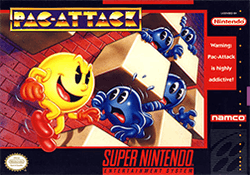Pac-Attack
| Pac-Attack | |
|---|---|
 Pac-Attack cover art (Super NES version) | |
| Developer(s) |
Namco Now Production |
| Publisher(s) | Namco |
| Platform(s) | Genesis, Super NES, Game Boy, Game Boy Color, Game Boy Advance, PlayStation 2, Xbox, GameCube, Game Gear, CD-i, iOS |
| Release date(s) | June 15, 1993 |
| Genre(s) | Puzzle game |
| Mode(s) |
Single-player Multiplayer (up to two players) |
Pac-Attack (パックアタック), known in some Japanese and European releases as Pac-Panic (パックパニック), is a puzzle game in the vein of Columns and Dr. Mario. It was adapted from Cosmo Gang the Puzzle, an arcade game released in the previous year.
Released by Namco, it features Pac-Man as the main playing pieces, with the Ghosts and blocks as obstacles.
The game was initially published in 1993 for the Genesis and Super NES. Game Gear and Game Boy versions followed in 1994. The Game Boy and Game Boy Color releases also feature a Super Game Boy enhanced color palette. Although Cosmo Gang the Puzzle was released to the arcades, there was never an arcade version of Pac-Attack. The game was also known as 'Pac-Man: Pac-Attack' and 'Pac-Panic'.[1]
It has been re-released on various Namco video game compilations such as the Game Boy Color's Pac-Man: Special Color Edition, Namco Anthology 2, Pac-Man Collection, Pac-Man World 2, the PS2/Xbox/GameCube version of Namco Museum, and the downloadable Pac-Man Museum. The SNES version was re-released on the Wii's Virtual Console download service in North America on January 14, 2008, with a European release following on June 27, 2008. It was released on the latter release for the Wii U Virtual Console on February 26, 2015.
Overview
On a Tetris-like board the player drops blocks consisting of Ghosts, Blocks, Pac-Man, and one Fairy (if the Fairy Meter is full) to the ground. The objective is to not let the blocks overflow, let Pac-Man eat the ghosts, and make lines to shorten the amount of blocks on the board. When Pac-Man eats a ghost, the Fairy Meter goes up. Once full, a fairy will eventually be dropped. Once the fairy comes to a stop by landing on anything, it waves its wand and every ghost in the eight lines below it will disappear, often resulting in numerous lines being completed and simplifying the board. Once the fairy disappears, the score bonus is given, and gameplay continues.
Pac-Attack can also be played in 2-player mode. Player 1 must eat Blinky, while Player 2 must eat Sue, the purple ghost from Pac-Mania. As players eat ghosts and complete lines, they will drop ghosts on their opponent's board, messing up their board and bringing them closer to the top. This game can even be played in puzzle mode. The object of this mode is to smash all 100 stages by getting rid all of the ghosts on the board with the limited number of Pac-Man's for each stage. In the event of a Game Over, all the regular blocks appear with red crosses on them. Players can then retry the level.
Version differences
SNES/Genesis/Game Gear/Game Boy
The original releases on the SNES, Genesis/Mega Drive, Game Gear, and Game Boy all share a similar interface and graphics (although these vary slightly due to different console's technical limitations) and they all have the same soundtrack (except for puzzle mode on SNES version).
Philips CD-I
The CD-I version features enhanced graphics, a new interface (wordless menu screens) and an introduction cinematic was planned to give the game a story (however this was abandoned due to time constraints).[2] This version was only released in Europe and was titled Pac-Panic.
Namco Anthology 2
This version of Pac-Attack includes new graphics, music, and modes, as well as some improvements over the 1993 version, such as a bar indicating when Pac-Man or the Fairy is coming and which Ghosts can and cannot be eaten. It also has a "Godhand" mode, where the player attempts to reach level 999 while all the blocks came down at intense speeds. Also, Pac-Man and the Fairy take longer to appear. The music was composed by Takaki Horigome, a musician from the Japanese band Kirinji. This version of Pac-Attack was released as an unlockable game in Pac-Man World 2 but with the puzzle mode omitted from the Namco Anthology 2 version removed.
iOS
It got a "demake" on the iOS that uses graphics from the original Pac-Man arcade game and was released in October 2010. The puzzle mode features more specific challenges on this version as opposed to previous versions.
Reception
Electronic Gaming Monthly gave the Game Gear version a 6.6 out of 10, commenting, "Not relying on fancy graphic effects, Pac-Attack is the type of puzzle game designed for Game Gear. ... play this game a few times and you'll definitely get hooked on this smaller version."[3] GamePro gave the Genesis version a mildly positive review, saying that the game's multiple play modes, while derivative, are enjoyable and challenging.[4] The December 1995 edition of British magazine CDi gave the CD-i version 80/100, and commented "Pac Panic should keep the little ones entertained" but felt adults would be better off with the version of Tetris released for the system.
References
- ↑ "Pac Attack at IGN.com". Retrieved 2007-06-15.
- ↑ http://www.blackmoonproject.co.uk/articles/pac_panic_the_missing_frames.php
- ↑ "Review Crew: Pac-Attack". Electronic Gaming Monthly (60). EGM Media, LLC. July 1994. p. 40.
- ↑ "ProReview: Pac-Attack". GamePro (64). IDG. November 1994. p. 102.